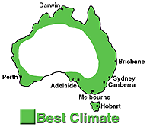Burke’s Backyard visited a beautiful 1.2ha (3 acre) garden in which the natural bushland blends successfully with Australian natives. The property, at Wentworth Falls in the Blue Mountains, is the home of John and Jill Gaibor, the former owners of Gaibor’s Nursery. Although the garden was planted eight years ago, the house is only eighteen months old. The brief that John gave the architect was to build a house that looks like a village, or in other words a house with many roofs. The walls are a very subtle yellow colour, and they provide an excellent backdrop for all the wonderful maples and deciduous shrubs planted around the house.
The plants
John loves conifers, and there are many in the garden, including a dwarf blue spruce (Picea pungens ‘Montgomery’). Another feature of the garden is the wonderful collection of maples. On the day of our visit Acer palmatum varieties ‘Osakazuki’ and ‘Shishigashira’ were in full colour, as well as various forms of A. palmatum ‘Dissectum’. Some of the maples are very rare in Australia, and were imported years ago by Harry Van de Ven of Toolangi Wholesale Nursery. Several natives fit very well into this scheme of planting, for example, Grevillea lanigera, which looks almost like a small conifer or an alpine plant. There are even banksias growing happily amongst the maples and rhododendrons. ‘Birthday Candles’ is a dwarf form of Banksia spinulosa, which only grows to about 45cm (1.5′) tall. This hardy plant grows well in most parts of Australia, but not in very hot and dry areas, or extremely frosty areas.
|
Pigeons at Gaibor House The idea of keeping pigeons appeals to many people, but they’re put off by the thought of having unsightly cages in the backyard. John has solved that problem by building a home for pigeons under the eaves of his own house. His birds are a type of pouter pigeon (the breed that puffs up the area around the neck), and they live in a variation on the dovecote or loft, right at the top of a very tall side wall of the house. There are entrance holes for the birds to come and go, as well as little platforms for them to sit on, and the centre panel can be removed for cleaning. John explained that in Europe where he grew up, everyone kept pigeons for food, and this was a very common way of housing them. It is a very tidy and practical way of keeping pigeons around the house without the need for ugly cages.
|



